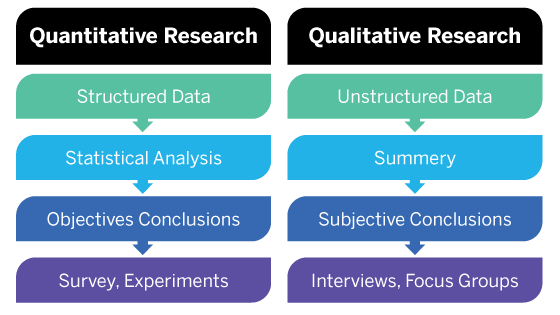What is qualitative research?
Qualitative research is a research method that collects non-numerical data. Typically, it goes beyond the information that quantitative research provides (which we will cover below) because it is used to gain an understanding of underlying reasons, opinions, and motivations.
Qualitative research methods focus on the thoughts, feelings, reasons, motivations, and values of a participant, to understand why people act in the way they do.
In this way, qualitative research can be described as naturalistic research, looking at naturally-occurring social events within natural settings. So, qualitative researchers would describe their part in social research as the ‘vehicle’ for collecting the qualitative research data.
Qualitative researchers discovered this by looking at primary and secondary sources where data is represented in non-numerical form. This can include collecting qualitative research data types like quotes, symbols, images, and written testimonials.
These data types tell qualitative researchers subjective information. While these aren’t facts in themselves, conclusions can be interpreted out of qualitative that can help to provide valuable context.
Because of this, qualitative research is typically viewed as explanatory in nature and is often used in social research, as this gives a window into the behaviour and actions of people.
It can be a good research approach for health services research or clinical research projects.
Quantitative vs qualitative research
In order to compare qualitative and quantitative research methods, let’s explore what quantitative research is first, before exploring how it differs from qualitative research.
Quantitative research
Quantitative research is the research method of collecting quantitative research data – data that can be converted into numbers or numerical data, which can be easily quantified, compared, and analysed.
Quantitative research methods deal with primary and secondary sources where data is represented in numerical form. This can include closed-question poll results, statistics, and census information or demographic data.
Quantitative research data tends to be used when researchers are interested in understanding a particular moment in time and examining data sets over time to find trends and patterns.
The difference between quantitative and qualitative research methodology
While qualitative research is defined as data that supplies non-numerical information, quantitative research focuses on numerical data.
In general, if you’re interested in measuring something or testing a hypothesis, use quantitative research methods. If you want to explore ideas, thoughts, and meanings, use qualitative research methods.
While qualitative research helps you to properly define, promote and sell your products, don’t rely on qualitative research methods alone because qualitative findings can’t always be reliably repeated. Qualitative research is directional, not empirical.
The best statistical analysis research uses a combination of empirical data and human experience (quantitative research and qualitative research) to tell the story and gain better and deeper insights, quickly.
Where both qualitative and quantitative methods are not used, qualitative researchers will find that using one without the other leaves you with missing answers.
For example, if a retail company wants to understand whether a new product line of shoes will perform well in the target market:
- Qualitative research methods could be used with a sample of target customers, which would provide subjective reasons why they’d be likely to purchase or not purchase the shoes, while
- Quantitative research methods into the historical customer sales information on shoe-related products would provide insights into the sales performance, and likely future performance of the new product range.
Approaches to qualitative research
There are five approaches to qualitative research methods:
- Grounded theory: Grounded theory relates to where qualitative researchers come to a stronger hypothesis through induction, all throughout the process of collecting qualitative research data and forming connections. After an initial question to get started, qualitative researchers delve into information that is grouped into ideas or codes, which grow and develop into larger categories, as the qualitative research goes on. At the end of the qualitative research, the researcher may have a completely different hypothesis, based on evidence and inquiry, as well as the initial question.
- Ethnographic research: Ethnographic research is where researchers embed themselves into the environment of the participant or group in order to understand the culture and context of activities and behaviour. This is dependent on the involvement of the researcher, and can be subject to researcher interpretation bias and participant observer bias. However, it remains a great way to allow researchers to experience a different ‘world’.
- Action research: With the action research process, both researchers and participants work together to make a change. This can be through taking action, researching and reflecting on the outcomes. Through collaboration, the collective comes to a result, though the way both groups interact and how they affect each other gives insights into their critical thinking skills.
- Phenomenological research: Researchers seek to understand the meaning of an event or behaviour phenomenon by describing and interpreting participant’s life experiences. This qualitative research process understands that people create their own structured reality (‘the social construction of reality’), based on their past experiences. So, by viewing the way people intentionally live their lives, we’re able to see the experiential meaning behind why they live as they do.
- Narrative research: Narrative research, or narrative inquiry, is where researchers examine the way stories are told by participants, and how they explain their experiences, as a way of explaining the meaning behind their life choices and events. This qualitative research can arise from using journals, conversational stories, autobiographies or letters, as a few narrative research examples. The narrative is subjective to the participant, so we’re able to understand their views from what they’ve documented/spoken.
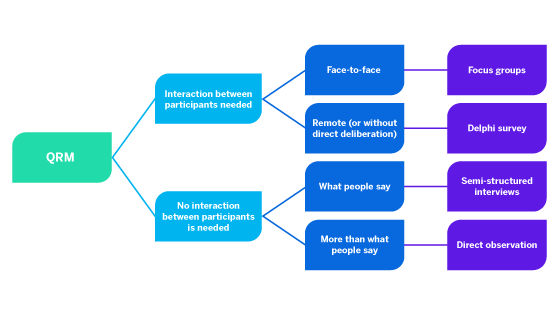
Qualitative research methods can use structured research instruments for data collection, like:
Surveys for individual views
A survey is a simple-to-create and easy-to-distribute qualitative research method, which helps gather information from large groups of participants quickly. Traditionally, paper-based surveys can now be made online, so costs can stay quite low.
Qualitative research questions tend to be open questions that ask for more information and provide a text box to allow for unconstrained comments.
Examples include:
- Asking participants to keep a written or a video diary for a period of time to document their feelings and thoughts
- In-Home-Usage tests: Buyers use your product for a period of time and report their experience
Surveys for group consensus (Delphi survey)
A Delphi survey may be used as a way to bring together participants and gain a consensus view over several rounds of questions. It differs from traditional surveys where results go to the researcher only. Instead, results go to participants as well, so they can reflect and consider all responses before another round of questions are submitted.
This can be useful to do as it can help researchers see what variance is among the group of participants and see the process of how consensus was reached.
Examples include:
- Asking participants to act as a fake jury for a trial and revealing parts of the case over several rounds to see how opinions change. At the end, the fake jury must make a unanimous decision about the defendant on trial.
- Asking participants to comment on the versions of a product being developed, as the changes are made and their feedback is taken onboard. At the end, participants must decide whether the product is ready to launch.
Semi-structured interviews
Interviews are a great way to connect with participants, though they require time from the research team to set up and conduct, especially if they’re done face-to-face.
Researchers may also have issues connecting with participants in different geographical regions. The researcher uses a set of predefined open-ended questions, though more ad-hoc questions can be asked depending on participant answers.
Examples include:
- Conducting a phone interview with participants to run through their feedback on a product. During the conversation, researchers can go ‘off-script’ and ask more probing questions for clarification or build on the insights.
Focus groups
Participants are brought together into a group, where a particular topic is discussed. It is researcher-led and usually occurs in-person in a mutually accessible location, to allow for easy communication between participants in focus groups.
In focus groups, the researcher uses a set of predefined open-ended questions, though more ad-hoc questions can be asked depending on participant answers.
Examples include:
- Asking participants to do UX tests, which are interface usability tests to show how easily users can complete certain tasks
Direct observation
This is a form of ethnographic research where researchers will observe participants’ behaviour in a naturalistic environment. This can be great for understanding the actions in the culture and context of a participant’s setting.
This qualitative research method is prone to researcher bias as it is the researcher that must interpret the actions and reactions of participants. Their findings can be impacted by their own beliefs, values, and inferences.
Examples include:
- Embedding yourself in the location of your buyers to understand how a product would perform against the values and norms of that society
Qualitative data types and category types
Qualitative research methods often deliver information in the following qualitative research data types:
- Quotes
- Symbols
- Images
- Written testimonials
- Speeches
Through contextual analysis of the information, researchers can assign participants to category types:
- Religion
- Gender
- Social class
- Political alignment
- Most likely to purchase a product
- Their preferred training learning style
Advantages of qualitative research
- Useful for complex situations: Qualitative research on its own is great when dealing with complex issues, however, providing background context using quantitative facts can give a richer and wider understanding of a topic. In these cases, quantitative research may not be enough.
- A window into the ‘why’: Qualitative research can give you a window into the deeper meaning behind a participant’s answer. It can help you uncover the larger ‘why’ that can’t always be seen by analysing numerical data.
- Can help improve customer experiences: In service industries where customers are crucial, like in private health services, gaining information about a customer’s experience through health research studies can indicate areas where services can be improved.
Disadvantages of qualitative research
- You need to ask the right question: Doing qualitative research may require you to consider what the right question is to uncover the underlying thinking behind a behaviour. This may need probing questions to go further, which may suit a focus group or face-to-face interview setting better.
- Results are interpreted: As qualitative research data is written, spoken, and often nuanced, interpreting the data results can be difficult as they come in non-numerical formats. This might make it harder to know if you can accept or reject your hypothesis.
- More bias: There are lower levels of control to qualitative research methods, as they can be subject to biases like confirmation bias, researcher bias, and observation bias. This can have a knock-on effect on the validity and truthfulness of the qualitative research data results.
How to use qualitative research to your business’s advantage?
Qualitative methods help improve your products and marketing in many different ways:
- Understand the emotional connections to your brand
- Identify obstacles to purchase
- Uncover doubts and confusion about your messaging
- Find missing product features
- Improve the usability of your website, app, or chatbot experience
- Learn about how consumers talk about your product
- See how buyers compare your brand to others in the competitive set
- Learn how an organisation’s employees evaluate and select vendors
6 steps to conducting good qualitative research
Businesses can benefit from qualitative research by using it to understand the meaning behind data types. There are several steps to this:
- Define your problem or interest area: What do you observe is happening and is it frequent? Identify the data type/s you’re observing.
- Create a hypothesis: Ask yourself what could be the causes for the situation with those qualitative research data types.
- Plan your qualitative research: Use structured qualitative research instruments like surveys, focus groups, or interviews to ask questions that test your hypothesis.
- Data Collection: Collect qualitative research data and understand what your data types are telling you. Once data is collected on different types over long time periods, you can analyse it and give insights into changing attitudes and language patterns.
- Data analysis: Does your information support your hypothesis? (You may need to redo the qualitative research with other variables to see if the results improve)
- Effectively present the qualitative research data: Communicate the results in a clear and concise way to help other people understand the findings.
Qualitative data analysis
Evaluating qualitative research can be tough when there are several analytics platforms to manage and lots of subjective data sources to compare.
Qualtrics provides a number of qualitative research analysis tools, like Text iQ, powered by Qualtrics iQ, provides powerful machine learning and native language processing to help you discover patterns and trends in text.
This also provides you with:
- Sentiment analysis — a technique to help identify the underlying sentiment (say positive, neutral, and/or negative) in qualitative research text responses
- Topic detection/categorisation — this technique is the grouping or bucketing of similar themes that can are relevant for the business & the industry (eg. ‘Food quality’, ‘Staff efficiency’ or ‘Product availability’)
How Qualtrics products can enhance & simplify the qualitative research process
Even in today’s data-obsessed marketplace, qualitative data is valuable – maybe even more so because it helps you establish an authentic human connection to your customers. If qualitative research doesn’t play a role to inform your product and marketing strategy, your decisions aren’t as effective as they could be.
The Qualtrics XM system gives you an all-in-one, integrated solution to help you all the way through conducting qualitative research. From survey creation and data collection to textual analysis and data reporting, it can help all your internal teams gain insights from your subjective and categorical data.
Qualitative methods are catered through templates or advanced survey designs. While you can manually collect data and conduct data analysis in a spreadsheet program, this solution helps you automate the process of qualitative research, saving you time and administration work.
Using computational techniques helps you to avoid human errors, and participant results come in are already incorporated into the analysis in real-time.
Our key tools, Text IQ™ and Driver IQ™ make analysing subjective and categorical data easy and simple. Choose to highlight key findings based on topic, sentiment, or frequency. The choice is yours.
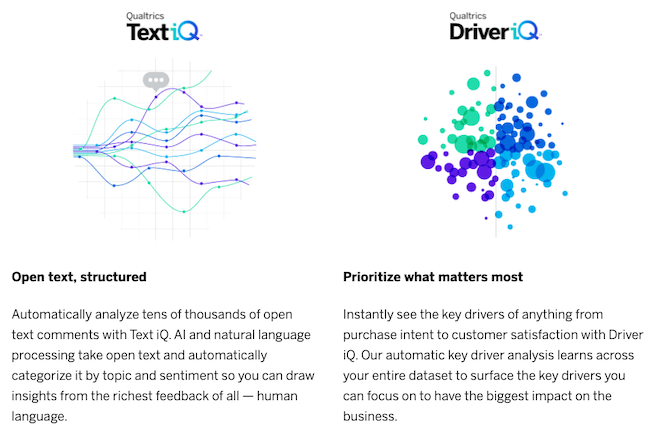
Some examples of your workspace in action, using drag and drop to create fast data visualisations quickly:
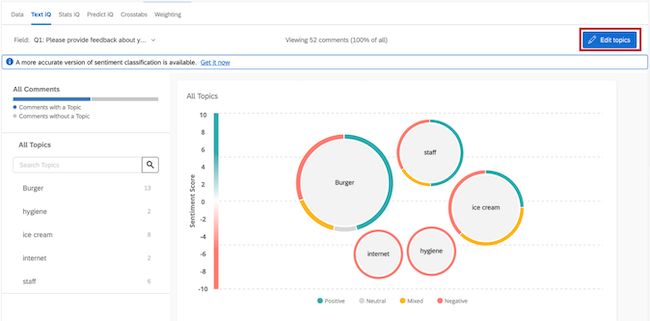
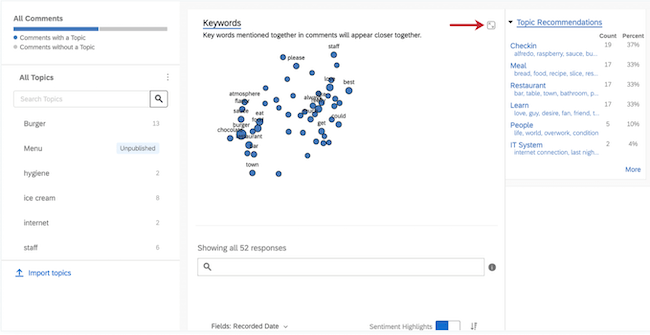
Find out how Qualtrics XM solution can help improve research team’s qualitative research
